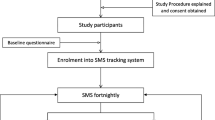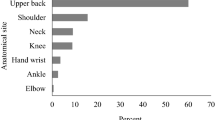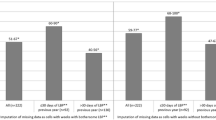Abstract
Purposes
We used two different methods to classify low back pain (LBP) in the general population (1) to assess the overlapping of individuals within the different subgroups in those two classifications, (2) to explore if the associations between LBP and some selected bio-psychosocial factors are similar, regardless which of the two classifications is used.
Method
During 1 year, 49- or 50-year-old people from the Danish general population were sent fortnightly automated text messages (SMS-Track) asking them if they had any LBP in the past fortnight. Responses for the whole year were then classified into two different ways: (1) In relation to the number of days with LBP in the preceding year (0, 1–30, and >30), (2) In relation to the frequency and duration of episodes of LBP (more or less never pain, episodic, and more or less constant pain). Some bio-psychosocial factors, collected with a questionnaire at baseline 9 years earlier, were entered into regression models to investigate their associations with the subgroups of the two classifications of LBP and the results compared.
Results
The percentage of agreement between categories of the two classification systems was above 68 % (Kappa 0.7). Despite the large overlap of persons in the two classification groups, the patterns of associations with the two types of LBP definitions were different in the two classification groups. However, none of the estimates were significantly different when the variables were compared across the two classifications.
Conclusion
Different classification systems of LBP are capable of bringing forth different findings. This may help explain the lack of consistency between studies on risk factors of LBP.

Similar content being viewed by others
References
Spitzer WO (1987) Scientific approach to the assessment and management of activity-related spinal disorders. A monograph for clinicians. Report of the Quebec task force on spinal disorders. Spine 12(7 Suppl):S1–S59
Leboeuf-Yde C, Lauritsen JM , Lauritzen T (1997) Why has the search for causes of low back pain largely been nonconclusive? Spine 22(8):877–881
Hestbaek L, Leboeuf-Yde C, Engberg M, Lauritzen T, Bruun NH, Manniche C (2003) The course of low back pain in a general population. Results from a 5-year prospective study. J Manipulative Physiol Ther 26(4):213–219
Axén I, Bodin L (2013) The Nordic maintenance care program: the clinical use od identified indications for prevention care. Chiropr Man Th 21:10
Axén I, Bodin L, Bergström G, Halasz L, Lange F, Lövgren PW, Rosenbaum A, Leboeuf-Yde C, Jensen I (2012) The use of weekly text messaging over 6 months was a feasible method for monitoring the clinical course of low back pain in patients seeking chiropractic care. J Clin Epidemiol 65(4):454–461
Leboeuf-Yde C, Rosenbaum A, Axén I, Jones JJ, Lovgren PW, Jorgensen K, Halasz L, Eklund A, Wedderkopp N (2009) The Nordic subpopulation research program: prediction of treatment outcome in patients with low back pain treated by chiropractors-does the psychological profile matter? Chiropr Osteopat 17:14
Kongsted A, Leboeuf-Yde C (2010) The Nordic back pain subpopulation program: can low back pain patterns be predicted from the first consultation with a chiropractor? A longitudinal pilot study. Chiropr Osteopat 18:8
Leboeuf-Yde C, Axén I, Jones JJ, Rosenbaum A, Lovgren PW, Halasz L, Larsen K (2005) The Nordic back pain subpopulation program: the long-term outcome pattern in patients with low back pain treated by chiropractors in Sweden. J Manip Physiol Ther 28:472–478
Axen I, Bodin L, Bergstrom G, Halasz L, Lange F, Lovgren PW, Rosenbaum A, Leboeuf-Yde C, Jensen I (2011) Clustering patients on the basis of their individual course of low back pain over a six month period. BMC Musculoskelet Disord 12:99
Von Korff M (1994) Studying the natural history of back pain. Spine (Phila Pa 1976) 19(18 Suppl):2041S–2046S
Leboeuf-Yde C, Lemeunier N, Wedderkopp N, Kjaer P (2013) Evidence-based classification of low back pain in the general population: one year data collected with SMS Track. Chiropr Man Th 21(1):30
de Vet HC, Heymans MW, Dunn KM, Pope DP, van der Beek AJ, Macfarlane GJ, Bouter LM, Croft PR (2002) Episodes of low back pain: a proposal for uniform definitions to be used in research. Spine 27(21):2409–2416
Kjaer P (2004) Low back pain in relation to lumbar spine abnormalities as identified by magnetic resonance imaging. PhD Dissertation, Faculty of Health Sciences, University of Southern Denmark, 11–54
SMS-Track website [http://www.sms-track.com]. Accessed 31 May 2010
Webb R, Brammah T, Lunt M, Urwin M, Allison T, Symmons D (2003) Prevalence and predictors of intense, chronic, and disabling neck and back pain in the UK general population. Spine 28(11):1195–1202
McNee P, Shambrook J, Harris EC, Kim M, Sampson M, Palmer KT, Coggon D (2011) Predictors of long-term pain and disability in patients with low back pain investigated by magnetic resonance imaging: a longitudinal study. BMC Musculoskelet Disord 12:234. doi:10.1186/1471-2474-1112-1234
Takatalo J, Karppinen J, Niinimäki J, Taimela S, Näyhä S, Mutanen P, Sequeiros RB, Kyllönen E, Tervonen O (2011) Does lumbar disc degeneration on magnetic resonance imaging associate with low back symptom severity in young Finnish adults? Spine (Phila Pa 1976) 36(25):2180–2189. doi:10.1097/BRS.2180b2013e3182077122
Cheung KM, Samartzis D, Karppinen J, Mok FP, Ho DW, Fong DY, Luk KD (2010) Intervertebral disc degeneration: new insights based on “skipped” level disc pathology. Arthritis Rheum 62(8):2392–2400. doi:10.1002/art.27523
Kjaer P, Leboeuf-Yde C, Korsholm L, Sorensen JS, Bendix T (2005) Magnetic resonance imaging and low back pain in adults: a diagnostic imaging study of 40-year-old men and women. Spine 30(10):1173–1180
Eyre D NP, Buckwalter JA et al(1989) Intervertebral disk: basic science perspectives. In: Ridge P (ed) New Perspectives on Low Back Pain edition. American Academy of Orthopaedic Surgeons, p. 147–207
Weishaupt D, Zanetti M, Hodler J, Boos N (1998) MR imaging of the lumbar spine: prevalence of intervertebral disk extrusion and sequestration, nerve root compression, end plate abnormalities, and osteoarthritis of the facet joints in asymptomatic volunteers. Radiology 209(3):661–666
Raininko R, Manninen H, Battié MC, Gibbons LE, Gill K, Fisher LD (1995) Observer variability in the assessment of disc degeneration on magnetic resonance images of the lumbar and thoracic spine. Spine (Phila Pa 1976) 20(9):1029–1035
Roberts N, Gratin C, Whitehouse GH (1997) MRI analysis of lumbar intervertebral disc height in young and older populations. J Magn Reson Imaging 7(5):880–886
Fardon DF, Milette PC (2001) Nomenclature and classification of lumbar disc pathology. Recommendations of the Combined task Forces of the North American Spine Society, American Society of Spine Radiology and, American Society of Neuroradiology. Spine (Phila Pa 1976) 26(5):E93–E113
Aprill C, Bogduk N (1992) High-intensity zone: a diagnostic sign of painful lumbar disc on magnetic resonance imaging. Br J Radiol 65(773):361–369
Modic MT, Steinberg PM, Ross JS, Masaryk TJ, Carter JR (1988) Degenerative disk disease: assessment of changes in vertebral body marrow with MR imaging. Radiology 166(1 Pt 1):193–199
Videman T, Battie MC, Gill K, Manninen H, Gibbons LE, Fisher LD (1995) Magnetic resonance imaging findings and their relationships in the thoracic and lumbar spine. Insights into the etiopathogenesis of spinal degeneration. Spine (Phila Pa 1976) 20(8):928–935
Yochum TRRL (1996) Diagnostic imaging of the musculoskeletal system. In: Baltimore M (ed) Essentials of Skeletal Radiology, 2nd edn. Williams and Wilkins, p. 373–475
Burton AK, Tillotson KM, Symonds TL, Burke C, Mathewson T (1996) Occupational risk factors for the first-onset and subsequent course of low back trouble. A study of serving police officers. Spine (Phila Pa 1976) 21(22):2612–2620
Papageorgiou AC, Macfarlane GJ, Thomas E, Croft PR, Jayson MI, Silman AJ (1997) Psychosocial factors in the workplace–do they predict new episodes of low back pain? Evidence from the South Manchester Back Pain Study. Spine (Phila Pa 1976) 22(10):1137–1142
Saltin B, Grimby G (1968) Physiological analysis of middle-aged and old former athletes. Comparison with still active athletes of the same ages. Circulation 38(6):1104–1115
Jacob T, Baras M, Zeev A, Epstein L (2004) Physical activities and low back pain: a community-based study. Med Sci Sports Exerc 36(1):9–15
Pincus T, Burton AK, Vogel S, Field AP (2002) A systematic review of psychological factors as predictors of chronicity/disability in prospective cohorts of low back pain. Spine (Phila Pa 1976) 27(5):E109–E120
Ware JE Jr (2000) SF-36 health survey update. Spine (Phila Pa 1976) 25(24):3130–3139
Ware JE Jr, Sherbourne CD (1992) The MOS 36-item short-form health survey (SF-36). I. Conceptual framework and item selection. Med Care 30(6):473–483
Bostick GP, Schopflocher D, Gross DP (2013) Validity evidence for the back beliefs questionnaire in the general population. Eur J Pain 17(7):1074–1081
Symonds TL, Burton AK, Tillotson KM, Main CJ (1996) Do attitudes and beliefs influence work loss due to low back trouble? Occup Med (Lond) 46(1):25–32
Dunn KM, Croft PR (2005) Classification of low back pain in primary care: using “bothersomeness” to identify the most severe cases. Spine 30(16):1887–1892
Leboeuf-Yde C, Lemeunier N, Wedderkopp N, Kjaer P (2014) Absence of low back pain in the general population followed fortnightly over one year with automated text messages. Chiropr Man Therap 22(1):21–22
Johansen B, Wedderkopp N (2010) Comparison between data obtained through real-time data capture by SMS and a retrospective telephone interview. Chiropr Osteopat 18:10
Sorensen SJ, Kjaer P, Jensen ST, Andersen P (2006) Low-field magnetic resonance imaging of the lumbar spine: reliability of qualitative evaluation of disc and muscle parameters. Acta Radiol 47(9):947–953
STATA/IC11.1 Software, Lakeway Drive, College Station, Texas, USA
Acknowledgments
The authors wish to thank Professor Tom Bendix for his role in designing the original study and securing primary funding (Industrial Insurance Company, now topdanmark). We also thank The Spine Centre of Southern Denmark for hosting the entire project and, in particular, for making the third data collection possible by supplying secretarial support and providing imaging of the participant. Professor Charlotte Leboeuf-Yde was partially funded for her Danish position, until December 31st, 2012, by Fonden til Fremme for Kiropraktisk Forskning og Postgraduat Uddannelse. Thank you to Laura Davies for her help with the English language.
Author information
Authors and Affiliations
Corresponding author
Ethics declarations
Conflict of interest
The authors state that they have no competing interest.
Appendix
Appendix
Rights and permissions
About this article
Cite this article
Lemeunier, N., Leboeuf-Yde, C., Gagey, O. et al. Do number of days with low back pain and patterns of episodes of pain have similar outcomes in a biopsychosocial prediction model?. Eur Spine J 25, 2774–2787 (2016). https://doi.org/10.1007/s00586-016-4531-3
Received:
Revised:
Accepted:
Published:
Issue Date:
DOI: https://doi.org/10.1007/s00586-016-4531-3




